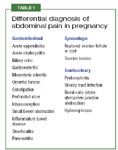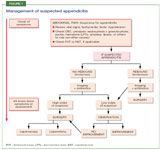Appendicitis in pregnancy: A guessing game?
Appendicitis in pregnancy should be treated as a surgical emergency. By quickly ruling out cholecystitis or pyelonephritis, surgery can begin before a burst appendix threatens a patient's life.

Abdominal pain is common in pregnancy and fortunately is usually from benign causes, such as round ligament pain, urinary tract infection, gastritis, or contractions. Even though appendicitis is an infrequent cause of abdominal pain during pregnancy (1 in 1,500–1 in 6,600 deliveries),1 it is a critical diagnosis to make. The differential diagnoses for abdominal pain make up a long list of benign-to-severe medical diagnoses that are the same for nonpregnant and pregnant women (Table 1). Appendicitis should lead the list because of its potentially serious maternal and fetal complications.
Appendicitis in pregnancy and the 'mortality of delay'
Perforation of the appendix can be as high as 66% in pregnant patients whose surgery is delayed more than 24 hours.6 The most common nonobstetric surgery during pregnancy, appendectomy accounts for 25% of nonobstetric surgeries in gravidas.6,7
Roadblocks to accurate diagnosis. Pregnancy itself does not alter the prevalence of appendicitis. Rather, the delay in diagnosis encountered in pregnancy increases the risk of perforation compared with nonpregnant women. The difficulty in making an accurate diagnosis during pregnancy results from the altered physical exam in pregnancy. These impediments include:
1. an expanding uterus that can displace the intra-abdominal organs, making the physical exam more difficult;
2. the high prevalence of common symptoms such as nausea, vomiting, and abdominal pain in the normal obstetric population; and
3. the general reluctance to operate unnecessarily on a gravid patient.8
Fetal mortality is most closely related to whether the appendix has perforated; however, the overall risk appears to be declining. Recent small studies have reported a fetal loss rate of 8% or less despite appendiceal perforation, with fetal loss rate dropping to less than 3% if no perforation has occurred.9,10

